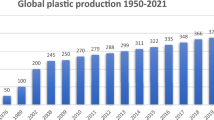Abstract
Histochemically demonstrable activity of a serine proteinase was detected in the penetration glands of Hymenolepis diminuta hexacanths. At the optimal pH of 8.4 the enzyme hydrolyzed Af-blocked L-aminoacyl- and N-blocked L-peptidyl-naphthylamides bearing L-arginine at the P1 subsite. The proteinase did not require either Ca2+ or Mg2+ for its activity and was insensitive to 1 mM EGTA and 1 mM EDTA. Organic fluorophosphates inhibited it, whereas thiol-blocking compounds did not. At operative pH values of 4.8 and 3.8 generated during electrophoresis in a stacking and a resolving gel, respectively, the proteinase migrated toward the cathode. When examined for proteolytic activity at the optimal pH of 8.4, the separated enzyme produced a single band of gelatinolysis in a gelatin-containing polyacrylamide gel. During in vitro maintenance of the hexacanths, the secretion from their penetration glands formed a mucous cyst surrounding the individual larvae. The cyst was resistant to and protected the hexacanths from the proteolytic activity of trypsin, papain, and proteinases extracted from the gut of the beetle Tenebrio molitor (the host). Hexacanths extracted from the hemocoel of T. molitor at 24 and 48 h after infection were surrounded by similar mucous cysts. Consequently, roles in penetration and protection for the secretion from the penetration glands are postulated.
Similar content being viewed by others
References
Hjertén S (1962) “Molecular sieve” chromatography on polyacrylamide gels, prepared according to a simplified method. Arch Biochem Biophys [Suppl 1]: 147–151
Lethbridge RC (1971) The hatching of Hymenolepis diminuta eggs and penetration of the hexacanths in Tenebrio molitor beetles. Parasitology 62:445–456
Lethbridge RC, Gijsbers MF (1974) Penetration gland secretion by hexacanths of Hymenolepis diminuta. Parasitology 68:303–311
Moczon T (1977a) Negative results of biochemical tests for collagenase and hyaluronidase activities in extracts from Hymenolepis diminuta (Cestoda) oncospheres and Nippostrongylus muris (Nematoda) invasive larvae. Bull Acad Pol Sci Ser Sci Biol Cl II 25:479–481
Moczon T (1977b) Penetration of Hymenolepis diminuta oncospheres across the intestinal tissues of Tenebrio molitor beetles. Bull Acad Pol Sci Ser Sci Biol Cl II 25:531–535
Moczon T (1993) Preparation of the oncospheres of the cestode Hymenolepis diminuta for experimental studies. Wiad Parazytol 39:171–178
Pence DB (1970) Electron microscope and histochemical studies on the eggs of Hymenolepis diminuta. I Parasitai 56:84–97
Reisfeld R, Lewis U, Williams D (1962) Disc electrophoresis of basis proteins and peptides on polyacrylamide gels. Nature 195:281–283
Schechter I, Berger A (1967) On the size of the active site in proteases. I. Papain. Biochem Biophys Res Commun 27:157–162
Smyth JD (1969) The physiology of cestodes. Oliver and Boyd, Edinburgh, pp 129–131
Stirewalt MA (1959) Isolation and characterization of deposits of secretion from the acetabular gland complex of cercariae of Schistosoma mansoni. Exp Parasitai 8:199–214
Stirewalt MA, Austin BE (1973) Collection of a secreted protease from the preacetabular glands of cercariae of Schistosoma mansoni. I Parasitai 59:741–743
Ubelaker IE, Cooper NB, Allison VF (1970) Possible defensive mechanism of Hymenolepis diminuta cysticercoids to hemocytes of the beetle Tribolium confusum. I Invertebr Pathol 16:310–312
Author information
Authors and Affiliations
Additional information
This work was supported by research grant PB 660049203 from the State Committee for Scientific Research
Rights and permissions
About this article
Cite this article
Moczon, T. A serine proteinase in the penetration glands of the hexacanths of Hymenolepis diminuta (cestoda, cyclophyllidea). Parasitol Res 82, 67–71 (1996). https://doi.org/10.1007/s004360050070
Received:
Accepted:
Issue Date:
DOI: https://doi.org/10.1007/s004360050070
Key words
- PVP Polyvinylpyrrolidone
- TRIS tris(hydroxymethyl)aminomethane
- Z-Arg-NHnap N-benzyloxycarbonyl-L-arginine-2-naphthylamide
- pHMB sodium p-hydroxymercuribenzoate
- NEM N-ethylmaleimide
- DFP diisopropyl fluorophosphate
- PMSF phenylmethanesulfonyl fluoride
- MOPS 3-(morpholino)propane sulfonic acid
- EGTA ethylene glycol-O,O′-bis(2-aminoethyl)-N,N,N′,N′-tetraacetic acid
- EDTA ethylenediaminetetraacetic acid
- HS-EtOH 2-mercaptoethanol
- EPPS N- (2-hydroxyethyl)piperazine-N′-(3-propanesulfonic acid)
- Z-N-benzyloxycarbonyl




